Gigrin Farm
Rhayader, Powys
|

Featured Location Guide
 |
.
| Mid Wales is the only area in the UK that
didn't loose completely a population of Red Kites, numbers did decrease but some
managed to beat extinction. Back in 1989 it is recorded that there were only 54
breeding left in Wales. In the early 1990's 6 red kites were roosting on the
farm and Mr Powell the owner was feeding them as and when food was available. In
the winter of 1992/3 he was approached by the RSPB to consider becoming the
Official Red Kite Feeding station, to allow the young Red Kites to stand a
better chance of survival, but also by opening to public that it would hopefully
deter people from visiting the nesting sites and disturbing the population.
Since then numbers have risen dramatically from around a dozen Red Kites coming
in to feed to now at times around 400-500 visiting over the winter months. The
Red Kites you see here are all native to Wales and not introductions in fact DNA
results carried out on some showed that they had all descended from a single
female. Gigrin Farm is a family run sheep
farm of approx. 200 acres. Its land is a minimum of 700ft above |
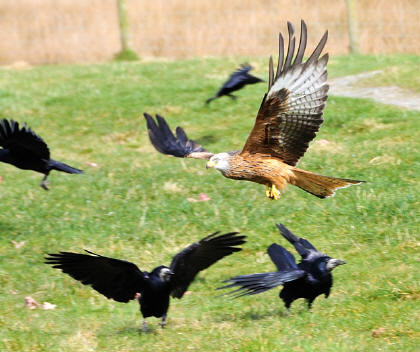

 Red Kites can collect the food but
prefer to force the other birds to fly and then steal the meat from
them.
Red Kites can collect the food but
prefer to force the other birds to fly and then steal the meat from
them. |
sea level with parts
rising to 1200ft, giving fantastic views over the Wye and Elan valleys in Mid
Wales. As well as the Red Kite Feeding station, there is also a Red Kite
information centre, picnic areas, a 1.5-2mile nature trail and it's 12 acre
woodland is leased to the RSPB for one of their reserves. It is now also a Red
Kite Rehabilitation Centre on behalf of the
The Welsh Kite Trust.
Red Kite Feeding Station. The Red Kites
are fed daily at 2pm in Winter and 3pm in Summer, and it is open to the public
364 days a year from 1pm. The feeding station is one particular area which is
fenced off to stop the sheep from entering and along one side has the viewing
hides, 3 of which are suitable for disabled visitors. The hides face east and
are just metres from where the kites swoop down to get the meat. They get
through around a quarter of tonne of fresh meat a week. There are also hides
that have
been specifically designed with photography/filming in mind and two are towers.
These specialist hides have additional costs involved in using them and
because the numbers of people that can go in them are restricted you should book
in advance as they are well used.
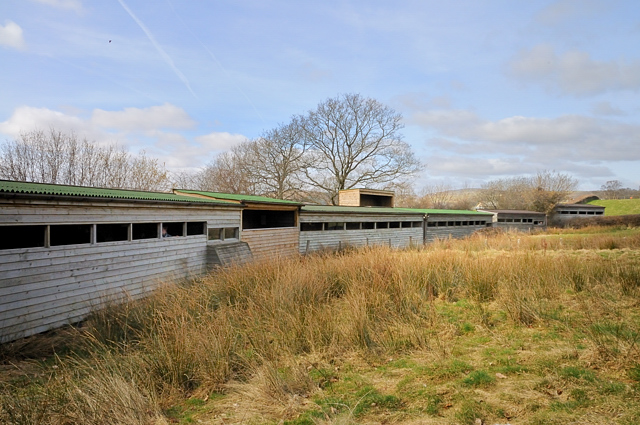 
The Tower Hide stands up behind the
ground level hides and has a partial roof and at the rear a bench, it also has a
green line on the floor which you have to stand behind. It has been designed
that they tripods can be used and for this reason is limited to 4 people with
tripods and 5 without. You should enter this hide at least 10 minutes before the
feeding begins and it is recommended that you do not wear coloured clothing that
will stand out as it is possible the birds can see you and will be put off
coming in. It costs £15 per person to use this hide, however this does include
the normal entry fee.
The Big Tower Hide also stands up behind the
ground level hides and has a partial roof and at the rear a bench, it also has a
green line on the floor which you have to stand behind, but it is larger and
stands 1.5m taller. It can accommodate 6 people with
tripods and 8 without. You should enter this hide at least 10 minutes before the
feeding begins and it is recommended that you do not wear coloured clothing that
will stand out as it is possible the birds can see you and will be put off
coming in. It costs £20 per person to use this hide, however this does include
the normal entry fee.
The Gateway Hide is in the towards the
centre of the ground level hides, and is about 12ft closer than the towers. It has a larger aperture than the normal
hides, which makes it easier for larger lenses to be used. It costs £10 per
person to use this hide but this also includes the normal entry fee and again it
is prudent to book in advance if you want to use it as it has a maximum of 6
people allowed.
The Wheelchair Accessible Hide has the
same roof arrangements as the tower, the front half having no roof, the rear
having cover just in case of unpredictable weather. There are also seats in this
hide for an assistant if required. The entrance to the hide is over 850mm wide
and there is room to part a vehicle next to the ramp. Its costs £8 per person to
use this hide but this does include the normal entry fee and gain it is prudent
to book in advance if you want to use it.
All these photographer/filming hides are gated so
that only those who have booked a place can enter.
You should enter these hides at least 10 minutes before the feeding begins and
it is recommended that you do not wear coloured clothing that will stand out as
it is possible the birds can see you and will be put off coming in.
See the
Photography and
Filming Hides
 page on their website for more details.
page on their website for more details.
All the hides are within metres of the feeding
area, however there is also a viewing area, near the picnic area, where you can
see the birds from above, and from here you get to see the large numbers in the
air.
When you visit
It is very popular and it is worth getting
there in plenty of time to choose the hide you want to be in and to get a good
position in the hide. As you wait for the 2pm/3pm start you will notice in the
surrounding fields and trees large numbers of crows, jackdaws and ravens
collecting, but also Kites will start to come in and circle round and perch in
the nearby trees. At 2pm/3pm the tractor comes along with the meat and it is spread
around the feeding area.
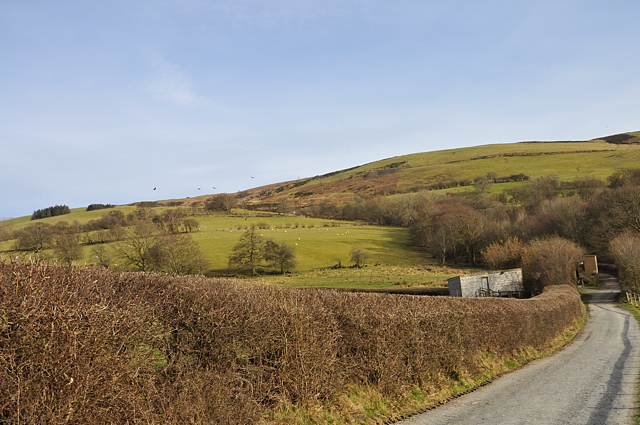 
Track down to the hides from
the car park, you can see the back and side of the hides
the area in front of them is the fenced in feeding area, and the trees in
the centre
of the picture is where the kites and other large birds tend to collect.
First in is usually the crows they give a
signal to the kites that it is safe to come in. Small numbers of kites will then
swoop in and grasp the meat in their talons, and held tightly in their feet
beneath their tail and fly off. They go really high up into clear airspace and
eat whilst flying. Not all swoops in are to grab the meat some will merely swoop
low over the crows of ravens heads and will try to make them rise from the field
with food so that they can then chase them and rob them in flight. As time
progresses numbers get larger and they come in from all angles and fast. They
circle, swoop, fly around, come towards you to go over the top of the hides, fly
in from left, right and every other angle you can think of. The hardest part is
keeping up with what you can see. All these opportunities allow you get photos
of them from all sort of angles. You will see some larger birds actually on the
ground feeding, these are usually buzzards who also come into feed, very few of
the Red Kites actually land preferring to feed whilst in flight high up. In fact
when you get home and find in some of your images black dots, at first you may
think it's dust, but it may also be just a Red Kite so high up feeding it got
into the background of your picture.
| The kites you see visiting on the day of your
visit are unlikely to have been there the day before as there is a rolling
population of red kites during the week. On any day, there is a pecking order
within the age groups, and hierarchy of the population and there will usually be
gaps of several minutes between their arrival, so once feeding begins some will
come in, then go really high up into the sky to feed on what they taken and it
will appear to you that they have all gone, but be patient and wait and another
batch will come in to provide more photo opportunities. |

In many places to see
a single Red Kite is a treat, here on occasions the sky is completely
full of them. |
We have more pictures of
the location, hides, birds sitting in the trees waiting, Kites spooking other
birds, Buzzards, Kites from all directions and far more within the two picture
galleries,
Girgrin Farm Gallery
 and
the larger
Red Kite Gallery. and
the larger
Red Kite Gallery.

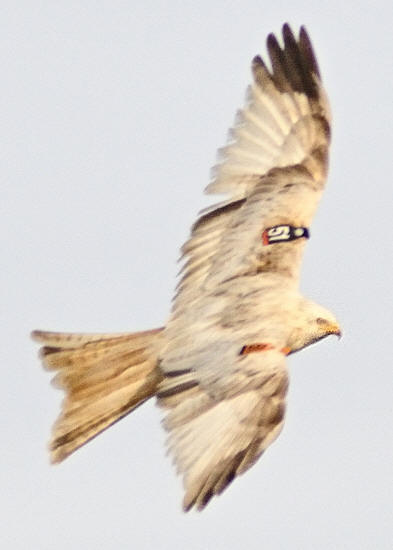 |
You may also get to see the White Kite, which
was hatched in 2003 just 30 miles west of Grigin. When it first visited it was
chased off by both the true Red Kites and the crows, but now is an accepted
member of the feeding group. It is not an albino but a Leucistic, which means it
is mainly pure white, but it has not entirely lost it's melanin pigment as it's
eyes are blue, where as albinos have pink eyes. In Wales one percent of
hatchlings show leucistic tendencies, thought to be because of the small gene
pool from which they come. They rarely survive very long in natural conditions,
but it is believed that the presence of the feeding station has helped in it's
survival. It is a spectacle worth seeing and we have
visited twice now each time being there for at least two hours, and each time it
is an awesome site and you come away with loads of pictures which you will slim
down the numbers when you get home and look at them in detail. From the last
visit in February 2009 between two of us we took over 1,000 photos over
two hours and you can see a selection of this in the
Girgrin
Farm Gallery
 and
the larger
Red Kite Gallery. and
the larger
Red Kite Gallery.
 We
could have produced another 5 galleries with the images that we had. All
of the images is as taken, we have sectioned and done a little editing
but we have not cut and paste or merged any images. We
could have produced another 5 galleries with the images that we had. All
of the images is as taken, we have sectioned and done a little editing
but we have not cut and paste or merged any images.
As well as the feeding station area there are
other things to see and do on a visit.
 |
The Information/Interpretive Centre has
lots of information on Red Kites and other birds and animals found in the
locality. A remote camera overlooks the feeding area and you can pan, zoom and
focus it. There is a set of 8 water colour paintings which tell the history of
the Red Kite. There are videos which show Red Kites in flight and nesting. There
is also video of the badgers on the farm. The computers give insights into the
various sounds and sights of the local raptors and provide education games and
quizzes with an environmental theme.
| The small shop has a variety of
merchandise, Red Kite themed including postcards, but it also has telescopes and
binoculars. During the winter months it also serves hot drinks. A small bird feeding station is also
provided, behind the toilet block, whose visitors include Brambling, Yellow
Hammers, Tree Sparrows, Siskin and Goldfinch amongst others.
The Nature Trail starts in the Picnic
Area and follows a waymarked trail for 1.5-2miles. It has information boards at
various points of the route and some benches are provided on the upward journey.
It is recommended that you follow the route clockwise as going backwards may
cause you to loose your bearings. Along this there is:
-
a
wetland project which attracts wetland birds such as Heron, but also you may see
frogs, fish and even a water vole
-
Trout
pools which attracts ducks, frogs etc
-
a
badger sett
-
Frog
Pond
-
Towards
the end of the journey you will come across green topped posts and these lead to
the RSPB reserve and if you are up to a longer walk this may be an attraction,
but it does add a further 3 miles.
Other Wildlife
As well as the Red Kites you also get other
birds coming into feed including, crows, jackdaws, ravens and buzzards. If you
take the nature trail you may also get to see fish, ducks, frogs and water vole
in the ponds and Badgers at the Badger sett on the nature trail
A truly remarkable day out for all the family,
and great photo opportunities for the Wildlife Photographer.
|
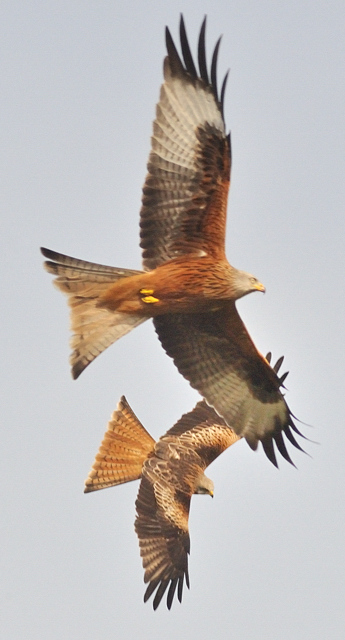  |
A
 is available, which links back to this page and a second gallery
features the
Red Kite, is available, which links back to this page and a second gallery
features the
Red Kite,

with images also taken at the same time.
| Further information Grid
|
Location: |
Gigrin Farm, Red
Kite Feeding Station, Rhayader, Powys |
|
Ceremonial County: |
Radnorshire
 |
|
Grid Reference: |
SN980677 |
|
Map Link: |
StreetMap
 |
|
Aerial photo: |
Google Aerial
 |
|
Route(s):
|
|
|
Best Times to Visit: |
Winter months, in snow
if you can get there, there are usually more Red Kites coming in 2008 saw up to 500
coming in to feed, but also reflections on snow and less shadowing on
underside of birds. All year round you will get something. |
|
E-mail: |
|
|
Website: |
www.gigrin.co.uk
 |
|
Other useful
websites: |
|
|
Nearby Locations: |
|
|
Other Relevant pages: |
Girgrin Farm

Red Kite

Where
to Photograph Red Kites

Red Kite

|
|
|
.
Planning Grid
|
Location: |
Gigrin Farm, Red
Kite Feeding Station, Rhayader, Powys |
|
Grid Reference: |
SN980677 |
|
Getting there: |
It is just off the A470 just half a mile south of Rhayader and north of Bluith Wells. From Hereford take the A44 to
Rhayader and then so south on the A470 towards Bluith Wells, the road
leading to the entrance to the Red Kit Feeding Station will be on your left,
and is marked. |
|
Access: |
From car park access through the picnic area
and down the farm track to the 5 hides. |
|
Parking: |
On site free parking 130 metres from hides. |
|
Facilities: |
Toilets, shop,
exhibition area, picnic area, 1.5-2 mile nature trail walk. Specialist hides
for photographers who want to use tripods or have more room, these are
charged extra see charges below. |
|
Things To Do,
See and Photograph: |
Red Kites - lots of
them at feeding times, small numbers of small garden birds |
|
What to take: |
telephoto lenses for
close ups. Warm clothes and hot drink most of the year. |
|
Nature highlights: |
Red Kites, Buzzards,
Crows, Ravens, Jackdaws |
|
Address: |
Gigrin Farm
South Street
Rhayader
Powys |
|
Postcode: |
LD6 5BL |
|
Telephone: |
01597 810243 |
|
Opening times: |
364 days a year from 1pm. Closed Christmas Day (25th December).
See website for times for feeding times, which is when most of the birds are
about. |
|
Charges: |
Adult £4.50; OAP £3.50; Child
£2 (4 and under FREE)
Gateway Hide £10; Tower Hide £15; wheelchair
accessible hide £8; Big Tower Hide £20; (these fees
include entry fee) |
|
Photo Restrictions: |
None |
|
Other Restrictions: |
|
|
Special Needs Access: |
3 hides are wheelchair friendly with ramps and
lower windows. Parking for up to 4 cars is possible right outside the hides,
for those not able to walk the 130metres from main car park. Low ramps
provide access to shop and Kite Centre information building. |
|
Special Needs Facilities: |
Disabled toilet, wheelchair accessible
photographers hide. |
|
Children Facilities: |
|
|
Dogs Allowed: |
On leads - this is a working farm. |
|

|
Please let us know any other information that we
can add to the Further information and Planning Grids or page and any errors that you discover. Before making a long trip to any location it is always
wise to double check the current information, websites like magazines may be
correct at the time the information is written, but things change and it is of
course impossible to double check all entries on a regular basis. If you have
any good photographs that you feel would improve the illustration of this page
then please let us have copies. In referring to this page it is helpful if you
quote both the Page Ref and Classification from the Grids above. To print the
planning grid select it then right click and print the selected area.
Please submit information on locations you discover so
that this system continues to grow.
|